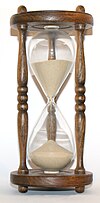Wikipedia:Today's featured article/August 7, 2008
The history of timekeeping devices begins thousands of years ago with the invention of the sexagesimal system of time measurement in approximately 2000 BC, in Sumer. The Ancient Egyptians divided the day into two 12-hour periods and used large obelisks to track the movement of the Sun. They also developed water clocks, which were probably first used in the Precinct of Amun-Re, and later outside Egypt as well. Other ancient timekeeping devices include the candle clock, used in China, Japan, England, and Iraq; the timestick, used in India and Tibet, as well as some parts of Europe; and the hourglass, which functioned similarly to a water clock. The first clock with an escapement, which transferred rotational energy into discrete motions, appeared in China in the 8th century, and Muslim engineers invented weight-driven clocks in the 11th century. Mechanical clocks were introduced to Europe at the turn of the 14th century, and became the standard timekeeping device until the 20th century. During the 20th century, quartz oscillators were invented, followed by atomic clocks. Atomic clocks are far more accurate than any previous timekeeping device, and are used to calibrate other clocks and to calculate the proper time on Earth; a standardized civil system, Coordinated Universal Time, is based on atomic time. (more...)
Recently featured: William Wilberforce – Ann Arbor – Holden
